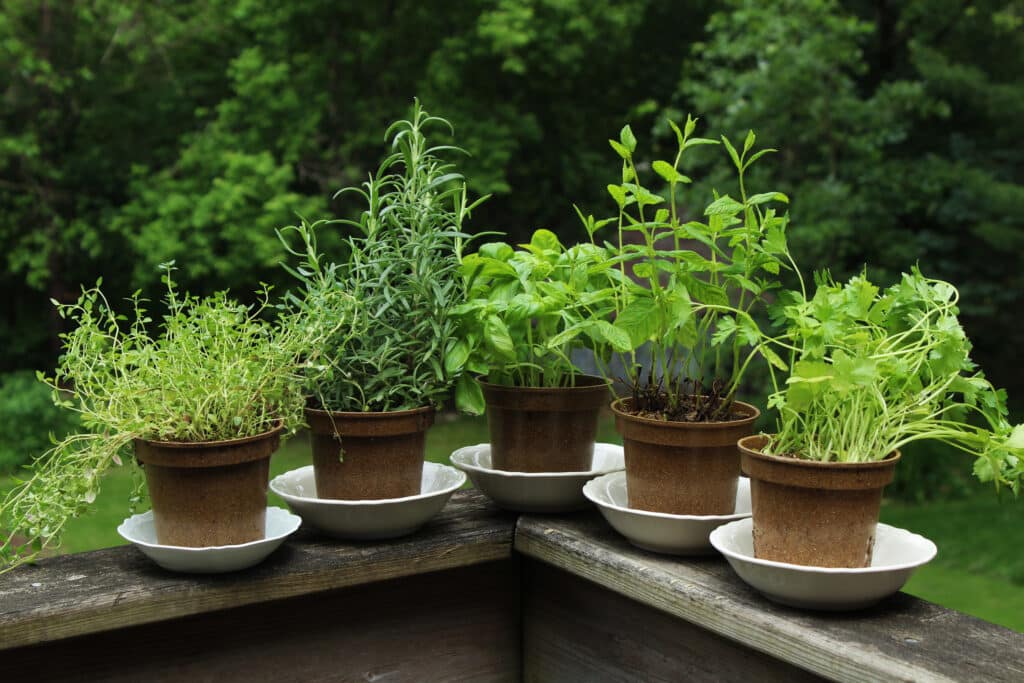Growing a DIY herb garden at home can be a fun and cost-effective way to add flavor to your dishes instead of buying store-bought herbs (which can be surprisingly expensive!). Whether you have a spacious garden or just a small balcony or even a window sill, growing your own herbs is a practical and eco-friendly hobby that can help you save quite a bit over time.
Why Grow Herbs at Home?
1. Cost savings
One of the most compelling reasons to grow herbs at home is the significant cost savings. Fresh herbs from the grocery store can add up, and store-bought dried herbs aren’t an adequate replacement in a lot of cases. By cultivating your own herbs, you’ll have a steady supply of fresh, flavorful additions to your meals without spending a lot.
2. Fresher is better
Homegrown herbs offer a taste and aroma that’s often even better than store-bought alternatives. It’s fun to go pick your own herbs as you need them, and
3. Sustainability
Growing herbs at home means you’re reducing emissions and fuel consumption from transportation and the environmental impact of retail packaging. By gardening sustainably, you’re contributing to a greener and more eco-friendly lifestyle.
4. Convenience
Having an herb garden at home means you won’t have to run to the store whenever you need a particular herb. Instead, you can simply step outside and harvest what you need, saving time and reducing waste.
How to get your DIY herb garden off to a strong start
1. Choose the right location
Select a sunny spot for your herb garden. Most herbs require at least 6-8 hours of sunlight daily. If you don’t have a garden, herbs can be grown in pots on a sunny windowsill or balcony.
2. Decide on herb selection
Start with a few herbs that you enjoy cooking with. Commonly-used herbs include basil, mint, thyme, rosemary, parsley, cilantro, and oregano. Consider your climate and growing conditions when you choose the herbs for your garden.
3. Obtain quality seeds or seedlings
Purchase high-quality herb seeds or seedlings from a reputable nursery or garden center. If you’re a beginner, using seedlings can make the process easier and give you a head start.
4. Prepare the soil
Ensure your garden soil or potting mix drains well and is nutrient-rich. Herbs generally prefer slightly alkaline to neutral soil. You can add compost or organic matter to improve the soil’s fertility.
5. Planting and Caring for Your Herbs
– Follow the instructions on the seed packet or plant your seedlings according to their planting recommendations.
– Water your herbs regularly, keeping the soil consistently moist but not super saturated. (Herbs usually don’t like to sit in water, so make sure there’s proper drainage.)
– Mulch around your herbs to retain moisture, keep weeds at bay, and provide insulation to the roots.
– Fertilize your herbs with a liquid fertilizer or compost every few weeks to promote healthy growth.
– Prune your herbs regularly for bushier growth.
– Protect your herbs from pests and diseases by regularly inspecting the plants and taking addressing any problems you find.
– Harvest your herbs frequently to encourage new growth. Use sharp scissors or pruning shears to cut the leaves or stems just above a node.
Tips for Herb Garden Success
1. Start small
If you’re new to gardening, start with a few herbs that you use most frequently in your cooking. As you gain confidence and experience, you can expand your herb garden repertoire.
2. Companion planting
Consider companion planting to deter pests and attract beneficial insects. For example, planting marigolds near your herbs can help keep pests away!
3. Preserve the excess
If you find yourself with more herbs than you can use, consider preserving them for later use. Drying, freezing, or making herb-infused oils and vinegars are all great ways to store and prolong the life of excess herbs.
4. Experiment with varieties
It can be fun to try different varieties of herbs. There are numerous variations available for most herb types, offering unique flavors and aromas.
5. Plan for year-round growth
Depending on your climate, you may need to bring potted herbs indoors during colder months or consider growing perennial herbs that thrive year-round.
6. Join gardening communities
Join local gardening communities, online forums, or social media groups to learn from experienced herb gardeners, ask questions, and exchange tips and advice.
DIY herb garden: the bottom line
Growing herbs at home is a rewarding and budget-friendly way to elevate your culinary creations while saving money on store-bought herbs. (For more ways to save at the grocery store, check out our article [link to this once it’s published: Eating well on a budget].) With a little planning, the right location, quality seeds or seedlings, and proper care, you can enjoy a thriving herb garden that provides you with an abundant supply of fresh, flavorful herbs throughout the year. Embrace your green thumb, nurture your herb garden, and savor the satisfaction of growing your own ingredients while reaping the benefits of homegrown herbs.









